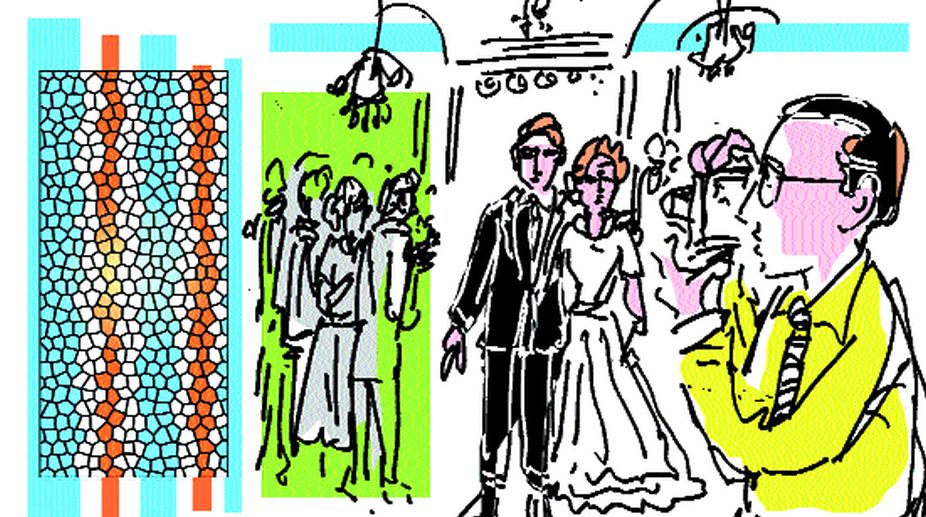‘Attacks on journalists increased in 2017’
The climate for journalism in India grew steadily adverse in 2017 with a host of perpetrators making reporters and photographers,…

I was at a superbly choreographed wedding in Loudoun County: an old country church, handsomely decorated, a patrician pastor with a leather-bound Bible in hand, and elegantly dressed men and women waiting expectantly in the pews. Precisely at the right moment began the third movement of Bach’s violin concerto in E major, and the bride marched forward on the arm of her father. I had known her as a young girl and wanted to see how splendid she looked in her bridal dress. I couldn’t. Two photographers were marching along the bride and taking shots every few inches. I couldn’t see past them.
The rest of the afternoon there were many replays of this drama. The wedding ceremony concluded with the groom kissing the bride, nervously and awkwardly, but at the multiple photographers’ insistence they had to reenact the scene a few times more. Toasts had to be repeated, as were some witty remarks by the groom’s cousin, all at the behest of the avid photographers. I thought I detected a slight look of relief on the couple’s face as their car finally took them away from the guests – and the photographers.
Advertisement
This accent on recording reality seems suddenly universal. You can go to the Grand Canyon and find more people taking pictures than observing the grandeur of the gorge. You can join the May crowd and visit the Eiffel Tower, and you will see hundreds furiously photographing the tower from every angle rather than taking a good look at it. At the zoo in Washington, dozens seem more interested to record the animals than notice their beauty or behavior.
Advertisement
No doubt the popularity of social media has heightened the trend. No private or social event goes unrecorded and then promptly reported in Facebook, Twitter, Tumblr or SnapChat. Every birthday cake, wedding dress and reunion buffet is duly splashed in serial photographs of dubious focus and dismal composition. Probably bakers are baking cakes, designers are sketching dresses and hosts are planning parties with the resulting photos firmly in mind.
Why does one take photos? You take a photo to aid your recall. You take a photo of your child so that you can look at it years later and remember how she looked as a baby. You take photos of your sunset gondola ride, for you love to think of your glorious summer in Venice even while you are freezing in Fargo or Fairbanks. The album brings back charming memories.
The other reason one takes photos is to share your experience. You send photos of a wedding or birthday to your cousin who couldn’t attend either. You make sure that Grandma gets to see snapshots of the reunion her gout did not let her attend. Were you to get to the peak of Everest, you may share with the world the unique view you beheld.
Is this what is spurring the tendency to shoot and publish virtually everything?
At least a part of the answer lies in the vast number of photographs that centre on the photographer as the source. Aside from the scourge of selfies, which are nearly always an eyesore, many pictures are of I-and-the-Tajmahal variety that leave you in little doubt which of the two objects is truly important. Perhaps we all crave a measure of immortality, and leaving a visual imprint on Facebook pages is some people’s way to grope for it.
But there is a price for this.
I was wandering in New York’s Whitney Museum, now located in a striking Renzo Piano building next to the Hudson River, and was suddenly transfixed by a remarkable canvas by Edward Hopper. It shows a nude woman standing in a shaft of sunlight from a window in a practically barren room. I stood petrified for a long time, watching and wondering: What is she thinking? Is that a cigarette in her fingers? When I came out of trance, I took a shot of the canvas, and meditated on it on my way back home.
Nothing detracted or even distracted from my joyous discovery of a work by a favorite painter or my leisurely absorption. Snapping it on my phone was a separate, subsequent act that let me see a little more of it. Seeing and recording were discrete actions, distinct in time and purpose. Shooting did not take away from a ‘mindful’ immersion in the painting itself.
Looking back, it makes me conscious of what we lose when we start snapping photos the moment we see something interesting: we really don’t see what sustained, attentive seeing alone lets us see.
The writer is a Washington-based international development advisor and had worked with the World Bank. He can be reached at mnandy@gmail.com
Advertisement